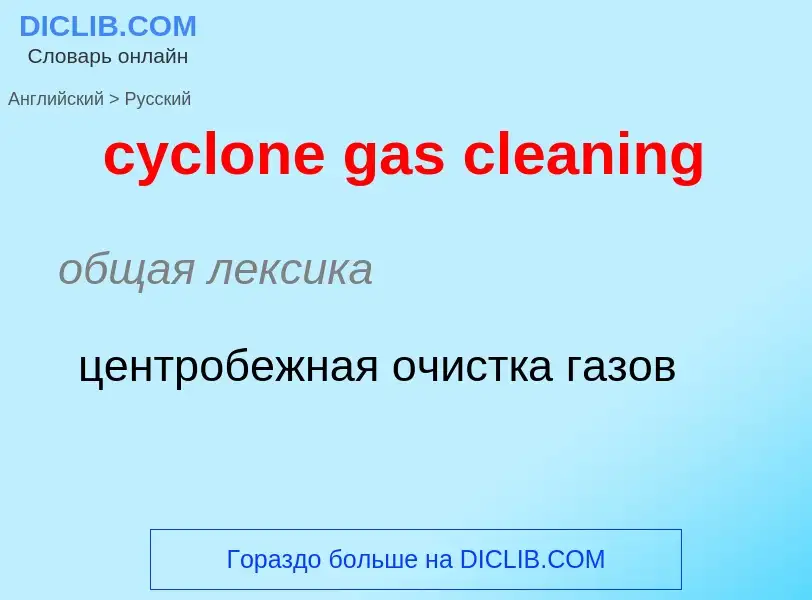Перевод и анализ слов искусственным интеллектом ChatGPT
На этой странице Вы можете получить подробный анализ слова или словосочетания, произведенный с помощью лучшей на сегодняшний день технологии искусственного интеллекта:
- как употребляется слово
- частота употребления
- используется оно чаще в устной или письменной речи
- варианты перевода слова
- примеры употребления (несколько фраз с переводом)
- этимология
cyclone gas cleaning - перевод на русский
общая лексика
центробежная очистка газов
строительное дело
циклонный пылеуловитель
Определение
Википедия

Cyclonic separation is a method of removing particulates from an air, gas or liquid stream, without the use of filters, through vortex separation. When removing particulate matter from liquid, a hydrocyclone is used; while from gas, a gas cyclone is used. Rotational effects and gravity are used to separate mixtures of solids and fluids. The method can also be used to separate fine droplets of liquid from a gaseous stream.
A high speed rotating (air)flow is established within a cylindrical or conical container called a cyclone. Air flows in a helical pattern, beginning at the top (wide end) of the cyclone and ending at the bottom (narrow) end before exiting the cyclone in a straight stream through the center of the cyclone and out the top. Larger (denser) particles in the rotating stream have too much inertia to follow the tight curve of the stream, and thus strike the outside wall, then fall to the bottom of the cyclone where they can be removed. In a conical system, as the rotating flow moves towards the narrow end of the cyclone, the rotational radius of the stream is reduced, thus separating smaller and smaller particles. The cyclone geometry, together with volumetric flow rate, defines the cut point of the cyclone. This is the size of particle that will be removed from the stream with a 50% efficiency. Particles larger than the cut point will be removed with a greater efficiency, and smaller particles with a lower efficiency as they separate with more difficulty or can be subject to re-entrainment when the air vortex reverses direction to move in direction of the outlet.
An alternative cyclone design uses a secondary air flow within the cyclone to keep the collected particles from striking the walls, to protect them from abrasion. The primary air flow containing the particulates enters from the bottom of the cyclone and is forced into spiral rotation by stationary spinner vanes. The secondary air flow enters from the top of the cyclone and moves downward toward the bottom, intercepting the particulate from the primary air. The secondary air flow also allows the collector to optionally be mounted horizontally, because it pushes the particulate toward the collection area, and does not rely solely on gravity to perform this function.
Large scale cyclones are used in sawmills to remove sawdust from extracted air. Cyclones are also used in oil refineries to separate oils and gases, and in the cement industry as components of kiln preheaters. Cyclones are increasingly used in the household, as the core technology in bagless types of portable vacuum cleaners and central vacuum cleaners. Cyclones are also used in industrial and professional kitchen ventilation for separating the grease from the exhaust air in extraction hoods. Smaller cyclones are used to separate airborne particles for analysis. Some are small enough to be worn clipped to clothing, and are used to separate respirable particles for later analysis.
Similar separators are used in the oil refining industry (e.g. for Fluid catalytic cracking) to achieve fast separation of the catalyst particles from the reacting gases and vapors.
Analogous devices for separating particles or solids from liquids are called hydrocyclones or hydroclones. These may be used to separate solid waste from water in wastewater and sewage treatment.





![Hurricane Alex]]. Hurricane Alex]].](https://commons.wikimedia.org/wiki/Special:FilePath/Alex 2016-01-10 1635Z.jpg?width=200)
![[[Hurricane Cristobal (2014)]] in the north Atlantic after completing its transition to an extratropical cyclone from a hurricane [[Hurricane Cristobal (2014)]] in the north Atlantic after completing its transition to an extratropical cyclone from a hurricane](https://commons.wikimedia.org/wiki/Special:FilePath/Cristobal Aug 29 2014 1615Z.jpg?width=200)



![[[Hurricane Fiona]] in the north Atlantic undergoing extratropical transition [[Hurricane Fiona]] in the north Atlantic undergoing extratropical transition](https://commons.wikimedia.org/wiki/Special:FilePath/Fiona 2022-09-23 1450Z.jpg?width=200)



![[[Cyclone Oratia]] showing the comma shape typical of extratropical cyclones, over Europe in October 2000. [[Cyclone Oratia]] showing the comma shape typical of extratropical cyclones, over Europe in October 2000.](https://commons.wikimedia.org/wiki/Special:FilePath/Storm Oratia 30 Oct 2000.jpg?width=200)

